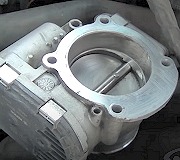I don't have an answer so I didn't reply, but I do have a few comments of value that may lead your thinking in a different direction. First, there is no such thing anymore as vapor lock. The fuel system is pumped to around 45 to 50 psi, then fuel circulates to the fuel rail on the engine, through the pressure regulator, then 99 percent of it goes right back into the tank. The little extra goes into the engine to be burned. The pump can easily move two or three gallons per minute, and any air would circulate right back into the tank.
Some things that contribute to the confusion include, "crank" and "turn over" are the same thing. Does it or doesn't it? That's the first thing to clear up so we know if we're working on a no-crank problem or a crank / failure-to-run problem.
"After driving it, if you shut it off for a few minutes it won't turn back on. It will crank but not... " This description agrees with a failure to run, but it's surprising the engine will run on starting fluid. Failure-to-run problems are typically caused by a fuel supply problem roughly three percent of the time, a lack of spark about two percent of the time, and a loss of BOTH fuel and spark at the same time the other 95 percent of the time. I wonder if the engine runs on starting fluid due to it self-igniting from the hot cylinders, and spark is actually missing?
That leads to my wondrous comment about a failure to restart when the engine is hot. That is a very common problem on all car brands when the crankshaft position sensor or the camshaft position sensor begins to fail by becoming heat-sensitive, then they work again after cooling down for about an hour. On older Chrysler engines, signals must be received from both sensors for the engine to run. Beginning somewhere around 2001 or 2002, both signals were needed for the engine to start, but once running, it would continue to run if one sensor failed. Then, with that failed sensor, the engine would not restart after being stopped. On still later models, possibly including a 2005 model, the engine will start and run, (poorly) when one sensor has failed.
The easiest way to see if you're having a sensor problem is to check the operation of the automatic shutdown, (ASD) relay. That gets turned on for just one second when the ignition switch is turned on, then it turns on again during engine rotation, (cranking or running). During that first one second, that is to bring fuel pressure back up for starting in case it bled off over days or weeks. Next, engine rotation is known by the signals from those two sensors. Use a test light to check the ASD relay operation. Look for the wire that is the same color at every injector, the ignition coil(s) or coil pack, or either of the two smaller terminals on the back of the alternator. That's usually a dark green / orange wire. Back-probe through the rubber weather seal alongside the wire at any one of those places. You can do this with a voltmeter too, but most don't respond fast enough.
Watch for the test light to turn on for one second when you turn on the ignition switch. That shows the circuit and relay are working. Next, watch if the test light turns on again when you start cranking the engine. If it does not, we have to look at those two sensor circuits. You will be missing spark, fuel pump, and injector pulses. If the test light does turn back on but the engine doesn't run, that's when we have to look for missing spark OR missing fuel.
See if that gives you some more ideas. I'll sit on the side to see if you guys need my wondrous wisdom.
Saturday, May 31st, 2025 AT 6:47 PM



